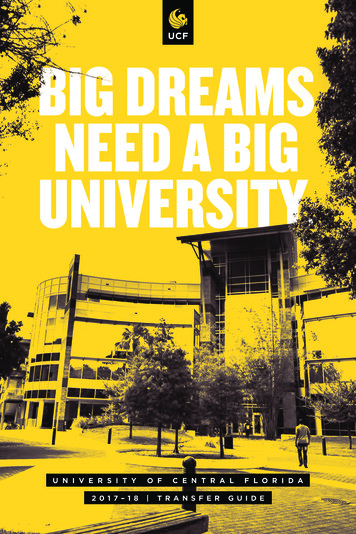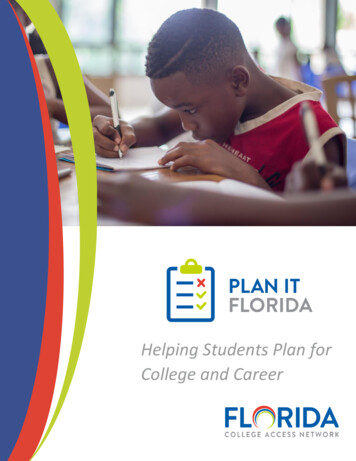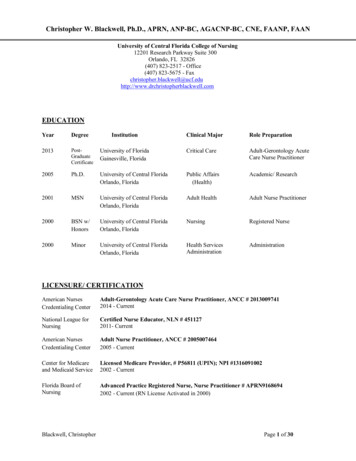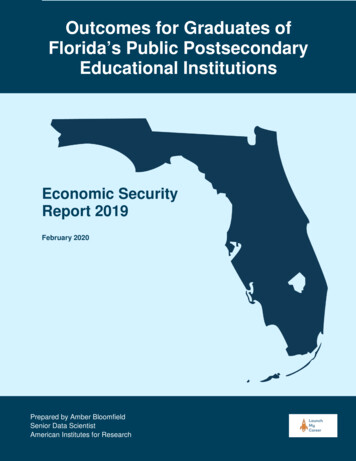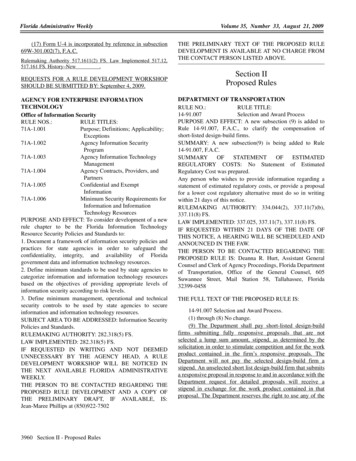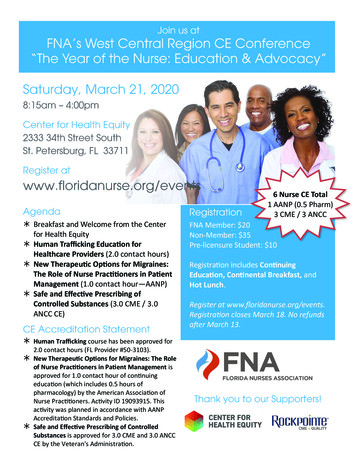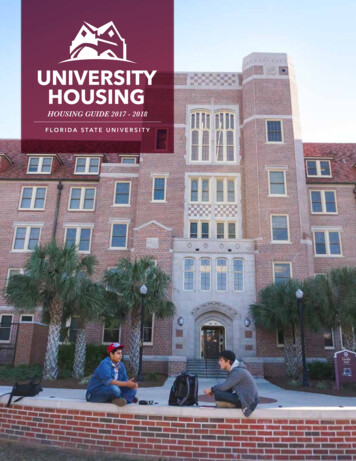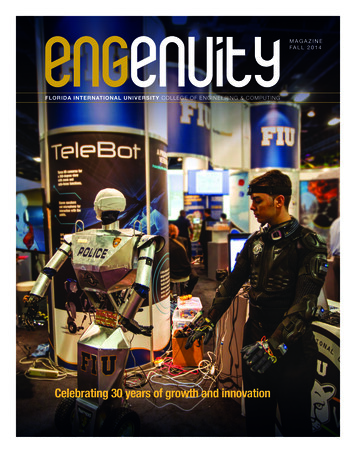
Transcription
MAGAZINEFA L L 2 0 1 4FLORIDA INTERNATIONAL UNIVERSITY COLLEGE OF ENGINEERING & COMPUTINGCelebrating 30 years of growth and innovation14061 ENG Magazine2.indd 110/10/14 3:22 PM
4SETTING NEW STANDARDSWall of Wind testing will strengthen Florida building codes6A BREAKTHROUGH UNFOLDSOrigami art inspires new construction of antennas and electronics8ON THE COVERON PATROLA real-life Robocop rolls out of FIU’s Discovery Lab1012A VISION OF HOPEEye research promises restoration of sight to the blindNANOTECH TAKES ON CANCERNanoparticles are scientists’ new weapon against ovarian cancerEditorial StaffRobyn NissimAlexandra PecharichMegan TiceDesign and ProductionOscar NegretSenior DesignerFIU External RelationsOffice of Publications14061 ENG Magazine2.indd 2On the coverFIU came on strong at the inaugural eMerge Americas Techweek Conference in Miami Beach, agathering of technology leaders in May. From its anchor position on the exhibit floor, FIU showcasedits most promising research. Among the big draws: The Discovery Lab’s TeleBot, a robot designedto help put disabled veterans to work as police officers. (See page 8 for the full story.) Other Collegeof Engineering & Computing innovations on display included Terrafly, a geographical databasemanagement system; a revolutionary prosthetic arm; and brain mapping research.10/10/14 3:22 PM
Florida International UniversityCollege of Engineering & ComputingBoard of AdvisorsPaul Johnston, ChairVice PresidentWATSCOFIU COLLEGE OF ENGINEERING & COMPUTING MAGAZINE FALL 2014Dear alumni, supporters and friends:Welcome to our first annual issue of Engenuity, a showcaseof our latest activities and accomplishments.As we celebrate our 30th anniversary, we look back on threedecades of solid progress. In the 2013-2014 academic yearAdalberto AlfonsoVice PresidentFlorida Turbine TechnologiesHumberto P. Alonso Jr.Vice President & District Director,South Florida Atkins GlobalAllan ArchPresidentSouthern Gear and Machine, Inc.Robert CarballoVice President, Transportation U.S. SouthStantecwithin the fields of engineering and computing, including:Alfred T. de CardenasExecutive Vice President &General Manager - AmericasSyniverse Technologies A 10 percent increase in our student body to a record high of about 6,000Carlos DuartPresidentCDR Maguire, Inc.alone we achieved records and earned recognition thatcontinue to confirm our place as an education and research institution of distinction A record high of 1,042 students graduated An all-time high of 15.8 million in research expenditures Near record high external research awards of 18.7 million Ranking as the nation’s 20th largest undergraduate engineering program Ranking 41 best online graduate engineering program in U.S. News & World ReportstThese numbers represent only half of our story. The other half is told each andevery day by our nearly 20,000 alumni who are making a difference through theirprofessional contributions in their field to their community. I wish to thank them forinvesting their trust in us. Through their commitment, alongside that of our excellentfaculty, we have become a diverse engineering education powerhouse, serving asthe top producer of Hispanic engineers and computer scientists in the nation and thesixth largest producer of African-American engineers.Our success speaks for itself. We have shown that if we can dream it, we canengineer it. Join us for the next leg of this exciting journey!Amir Mirmiran, Ph.D., PE, Fellow ASCE, Fellow ACIVasant H. Surti Professor and DeanDanny KatzCEODBK ConceptsRobert LeporeSenior Vice PresidentAECOMPastor LopezVice President & General ManagerAAR Landing Gear ServicesCarlos MallolDirector of StrategyMWH GlobalBryan J. OlnickVice President, Distribution OperationsFlorida Power & Light CompanyGus PegoDistrict #6 SecretaryFlorida Department of TransportationKelly RomanoVice President of Business DevelopmentUnited Technologies CorporationAdalio SanchezGeneral Manager, System XIBM Systems & Technology GroupThe FIU College of Engineering and Computing is South Florida’s leading engineering education resource. The college offers a complete range offully accredited engineering baccalaureate, master’s and doctoral degree programs in biomedical, civil and environmental, electrical and computer,mechanical and materials engineering; construction management; and computing and information sciences. The college is committed to diversityand is the country’s largest producer of Hispanic engineers as well as one of the top producers of African-American engineers and females withdoctoral degrees in engineering. Learn more at cec.fiu.edu.COLLEGE OF ENGINEERING & COMPUTING14061 ENG Magazine2.indd 1110/10/14 3:22 PM
in bri fNew “stress test” could helpsoldiers manage PTSD in real timeFIU researchers are developing a test that would allow individuals to easily andquickly measure their own levels of the so-called stress hormone cortisol. Thatwould mean soldiers and others suffering from post-traumatic stress disordercould check on their health anywhere at any time and immediately beginmanaging their condition.Cortisol levels currently are measured by taking blood or saliva samples thatthen must be sent to a lab. The team’s goal is to develop a simple way forindividuals to test and secure a measurement using saliva samples athome or work. A 50,000 grant from the National Science Foundation’sInnovation Corps program is supporting the researchers in their questto get the home test to market.Released by the adrenal gland as part of the fight-or-flightmechanism, cortisol in elevated levels can cause depression,mental illness and heart disease, among other problems.3D lab a boost to school of constructionFaculty and students in FIU’s OHL School of Constructionassist both faculty and students in their development ofhave a new visualization and simulation lab, thanks to astrong research proposals in construction engineering and 250,000 gift from Moss and Associates, the state’s third-management. At the same time, the lab will serve as anlargest building contractor.important educational tool.The work made possible by the lab will solidify FIU’s position as a leading teaching and researchinstitution for the construction industry.”The Moss and Associates Built Environment Informatics“Construction education relies heavily on real-world data andLaboratory will allow the school to move forward built-case studies to facilitate student learning in the classroom,”environment research that has the potential to benefitsaid Irtishad Ahmad, director of the OHL School ofacademic and industry partners across the nation.Construction. “Virtual simulation of building and constructionprocesses help deliver nearly real-life experience to students.The lab will support researchers who rely on high-performancecomputing and computation infrastructure to performWith this new laboratory we will be able to explain complexmodeling, analysis, simulation and optimization. It willconstruction processes to our students very effectively.”214061 ENG Magazine2.indd 2FLORIDA INTERNATIONAL UNIVERSITY10/10/14 3:22 PM
TOP50FIU writes the book onbuilding bridgesAs the nation struggles to address its crumbling transportationinfrastructure, a new guide developed by a multidisciplinary team ofexperts will help engineers better design bridges to withstand thetest of time.The 800-page Design Guide for Bridges for Service Life isintended to be version 1.0 of a living document that provides asystematic framework for creating bridges that last 100 years ormore. The comprehensive publication took five years to completeand is part of the 256 million Second Strategic Highway ResearchProgram approved by Congress in 2006.“It’s a paradigm shift in our thinking and the way we look atbridge design,” said Atorod Azizinamini, principal investigator onthe project and director of FIU’s federally funded Accelerated BridgeConstruction University Transportation Center. “This documentmakes you think through the process, go through the what-ifs andcome up with a solution.”U.S. News ranks FIU Top50 among online graduateengineering programsThe online graduate engineering program offered byFIU’s College of Engineering & Computing is amongthe nation’s best, according to the latest rankings byU.S. News & World Report.FIU ranked among the top 50, tied with theUniversity of Illinois–Chicago and the University ofNebraska–Lincoln. FIU ranked third among all theschools ranked in the report in faculty credentialsand training. Other areas U.S. News ranked onlineprograms include student engagement, studentservices and technology, admissions selectivity andpeer assessment.FIU accepts “electrifying” donation“Given the rapid growth of online engineeringFlorida Power & Light donated an electric vehicle to the College ofbe at the forefront in this arena,” said Amir Mirmiran,Engineering & Computing to energize student research and testingdean of the College of Engineering & Computing.of wireless charging technology. Work coming out of the collegeThe college has increased its enrollment to nearlycould ultimately help boost continued adoption of electric vehicles6,000 students, and future growth needs to bein Florida. The utility company began “greening” its own fleet inaccommodated through online and high-tech modes2006 and today operates more than 600 electric and hybrid vehiclesof delivery. At the same time, the college is adoptingthroughout the state.a high-touch approach to its high-tech education.programs around the country, it is crucial for FIU toThe OHL School of Construction has offered onlinegraduate courses that lead to the Master of Sciencein Construction Management, FIU’s only fully onlinegraduate engineering program. One of the first fullyonline construction programs in the country, theprogram has steadily grown and is popular amongprofessionals working in the construction industryand in governmental agencies. Students from allover the United States, as well as from Norway,Germany, Iraq and many Latin American andCaribbean countries have enrolled in the program.COLLEGE OF ENGINEERING & COMPUTING14061 ENG Magazine2.indd 3310/10/14 3:22 PM
Wall of Wind testing could helpmake homes, buildings safer in stormsThe National Oceanic and Atmosphericmost powerful university storm research facility – it wasAdministration forecast El Niño conditionsimpossible to gauge just how South Florida constructionin the Atlantic in 2014, predicting awould fare in the face of a major storm. By the nextsmaller number of hurricanes than average. But thehurricane season, the Wall of Wind — in partnership withoverwhelming consensus among scientists worldwideMiami-Dade County – hopes to have completed testsis that storms will continue to increase in both frequencyon how well different building products hold up underand severity over the middle and long runs. And even adifferent natural disaster scenarios.small storm can inflict huge losses if a structure is notstrong enough.Currently there is a mandatory building code, but this isa negotiated, consensus–based minimum for the level“The general public thinks they’re safe if the building or their home is builtto code. But that begs the question: safe against what?”of hazards and risk that a community faces, explainsRich Olson, director of FIU’s Extreme Events Instituteand the IHRC. The problem is in the “minimum.” And414061 ENG Magazine2.indd 4Building code provisions, particularly for the Miami-“the general public thinks they’re safe if the building orDade High Velocity Hurricane Zone, have beentheir home is built to code. But that begs the question:revised and tightened in the last two decades basedsafe against what?” asks Olson. Since the code mainlyon lessons learned from previous storms. But untiltargets mid-level hazards, like a Category 3 hurricane,FIU’s International Hurricane Research Center (IHRC)this means buildings and homes are inherently at riskintroduced the Wall of Wind (WOW) – the largest andfrom anything stronger, such as a Category 4 storm, letFLORIDA INTERNATIONAL UNIVERSITY10/10/14 3:22 PM
Wall of Wind takesnational stageA scaled replica of FIU’s powerful, oneof-a-kind hurricane simulator, the Wallof Wind (WOW), is the centerpiece of anexhibition at the National Building Museumin Washington, D.C. Running throughAugust 2, 2015, Designing for Disastersexplores new solutions to a range ofnatural hazards, among them earthquakes,storm surge, tsunamis, wildfires andhurricanes.The WOW feature spotlights FIU’s role asa national leader in hurricane mitigationresearch and gives museumgoers anopportunity to interact with a mini versionof the Miami-based facility, which isthe only one in the world capable ofgenerating wind speeds equivalent toCategory 5 hurricanes. Visitors can controlthe fan on display as they, literally, try toblow the roof off a house.“The exhibit is striking and highlights thatwe need not be passive in confrontingrisks of all kinds, including hurricanes,”said Richard Olson, director of FIU’sExtreme Events Institute and theInternational Hurricane Research Center.“We are honored to be contributing topublic awareness efforts.”alone a Category 5. Just because something is “built toArindam Chowdhury, director of IHRC’s Laboratorycode” doesn’t mean that it’s necessarily safe or secure infor Wind Engineering Research, says WOW is testinga higher category storm. And, as a hurricane is so oftennew ways to ensure that structures survive naturala “multi-hazard event,” it is the combination of wind andcatastrophes. “It is not enough to test winds straightstorm surge that has the most devastating impact.on,” he says. “We are looking at different wind directionscombined with wind-driven rain to see where there are“The second part of the problem is that the eventsappear to be changing,” Olson notes. “So that basicallymeans you’re getting sliced from two sides of the samesword. Code isn’t what people think it is — and thehazards are increasing,” he says.vulnerabilities in a building and whether prescriptive codeguidelines are actually effective.” These distinctions willbe critical in the many storm seasons to come.After all, South Florida knows well that NOAA forecastsMiami-Dade County official Jaime Gascon recognizeddo not necessarily equate to calm conditions in thisthe level of uncertainty even in brand new constructiontropical climate. There were El Niño conditions in 1992so he began working with IHRC and the WOW to createwhen Hurricane Andrew blew through the region and ledan enhanced building code. “We want to see what isto a new building code in Miami-Dade County. As theworking and where we need to tweak things,” sayssaying goes in hurricane country, “It only takes one stormGascon. “This is the science and the research to showif it’s a direct hit.”where it is necessary.”COLLEGE OF ENGINEERING & COMPUTING14061 ENG Magazine2.indd 5510/10/14 3:23 PM
ORigamiancient art inspires a new generationof compact antennas and electROnics614061 ENG Magazine2.indd 6FLORIDA INTERNATIONAL UNIVERSITY10/10/14 3:23 PM
Professor Stavros Georgakopoulos, right, in the lab with doctoral student Shun YaoFIU researchers are using technology andPossible applications for the antennas include aprinciples derived from the traditionalrange of military and commercial uses, includingJapanese art of origami to create remarkablycommunications equipment, wireless sensors, healthcompact and incredibly efficient antennas andmonitoring sensors, portable medical equipmentelectronics.and many other applications.“By using origami geometries we can reconfigureA traditional paper-folding art, origami includesantennas to whatever shape fits our purpose,” saidboth modular and moving types of structures.Stavros Georgakopoulos, assistant professor in FIU’sMathematicians recently have focused on theDepartment of Electrical & Computer Engineering.theoretical and practical questions raised by origami,“These geometries offer unique advantages ofresulting in technical advances in many areas.“Asoldier will be able to carry a powerful antenna into combat foldedin his back pocket.”collapsibility. That’s important for a number ofOrigami structures can be fabricated from a wideapplications, such as technology that needs to bevariety of materials. While Georgakopoulos mainlylaunched in space or used on the battlefield.”uses paper, he is also exploring plastics and flexibledielectrics. The researchers use sophisticated inkjetGeorgakopoulos is working with colleagues atprinting to deposit conductive materials such asGeorgia Tech with the support of a 2 millioncopper or silver onto paper to create antennas withgrant from the National Science Foundation. Thenovel signal reception and other capabilities.team is working on the development of uniqueantenna shapes that can be folded down to aIn January 2014, Georgakopoulos organized a workshopcouple of centimeters and expanded into muchat FIU for academics, industry and governmentlarger spaces with powerful, ultra-broadbandrepresentatives, and renowned origami artists. Acapabilities.second workshop is planned for 2015.COLLEGE OF ENGINEERING & COMPUTING14061 ENG Magazine2.indd 7710/10/14 3:23 PM
Discovery LabStudents build theirown version ofRoboCopResearchers andstudents in FIU’sDiscovery Lab havedeveloped the initialprototype of aTeleBot— which combinestelepresence and robotics— to allow disabled policeand military personnel toserve as patrol officers.814061 ENG Magazine2.indd 8FLORIDA INTERNATIONAL UNIVERSITY10/10/14 3:23 PM
FIU students collaborate on a variety of projects.Demonstrations of the prototype have beentaking place throughout 2014, and the projecthas received incredible media attention, includingfeatures on Fox News and the Discovery Channel.Unlike the RoboCop of the movie, the FIU TeleBotis not expected to cause damage to life orproperty.The TeleBot project began in 2012 when JeremyResearchers and students have worked for morethan 18 months to refine technology that will allowa disabled person to control the robot remotely,see everything the robot “sees” and interact withmembers of the public.“What impresses me most about the TeleBot“This kind of project requires a lot of hard work,technical expertise and resources,” said AmirMirmiran said the TeleBot is a product of theMirmiran, dean of the FIU College of Engineeringand Computing. “We had to build everything fromscratch. The students are very motivated and feellike they are making a real contribution.”of-the-box thinking to tackle real problems withRobins, a lieutenant commander in the U.S. NavyReserves, donated 20,000 to the Discovery Labto develop an idea he had to bring disabled lawenforcement officers, as well as disabled combatveterans, back to the force.Three HDcameras fora 360-degreeview with zoomand auto-focusfunctionsprototype is that most of the work was performedby undergraduate students operating under verytight budget and time constraints,” Robins said.Stereo speakersand microphonefor interactionwith the publicimagination of faculty and students who apply out-Having overcome multiple challenges, chief amongthem proper hand functioning, the team hasfinished work on a prototype that stands six feettall, weighs about 75 pounds and can be controlledfrom a remote location.smart solutions at affordable costs.“The project has far-reaching impacts on theeducation side as well, since we know that robotsare great tools to get students of all ages engagedin engineering and computer coding,” Mirmiran said.COLLEGE OF ENGINEERING & COMPUTING14061 ENG Magazine2.indd 9FEATURESGPS-synchronizedmap and autopilotfunction for easynavigation inpatrol areasPerimetersensors to warnof approachingobjects910/10/14 3:23 PM
EYERESEARCH1014061 ENG Magazine2.indd 10FLORIDA INTERNATIONAL UNIVERSITY10/10/14 3:23 PM
RETINAL IMPLANTCOULD RESTORE SIGHT FOR THE BLINDPeople who are blind as a result ofimprovements in the density of that feed-through willcertain diseases or injuries may havegreatly improve the quality of the image the personrenewed hope of seeing again thankswearing the device will see.to a retinal implant developed with thehelp of Florida International University’s W. KinzyThe retinal implant was designed for people who lostJones, a professor and researcher in the College ofvision due to injury to the eyes; progressive visionEngineering & Computing.loss caused by eye disorders (also known as retinitispigmentosa); or age-related macular degeneration,A tiny video camera mounted on special glasseswhen the center of the retina that is responsiblecaptures the scene in the patient’s environment, andfor central vision deteriorates. According to thea pocket controller relays the captured video signalNational Institutes of Health, age-related macularto the implant. Inspired by cochlear implants thatdegeneration is a leading cause of vision loss incan restore hearing to some deaf people, the retinalAmericans 60 years of age and older.implant works by electrically stimulating nerve cellsthat normally carry visual input from the retina to the“The impact of this technology, which increases thebrain, and bypassing the lost retinal cells.available pixels that can be stimulated, will bring“The impact of this technology will bring enhanced visualacuity to people with debilitating eye loss.”The Boston Retinal Implant Project, a highly-enhanced visual acuity to people with debilitatingspecialized, academically-based team of 30eye loss,” Jones said. “My mother had macularresearchers that includes Jones, was responsible fordegeneration, and I saw the quality of her lifebringing the implant to light. The group comprisesdegrade as the disease progressed. Hopefully, whenbiologists and engineers from Harvard, Cornell,these devices are available for FDA-approved use,Massachusetts Institute of Technology (MIT) and otherstotal loss of eye sight from macular degeneration orwho are developing new technologies for the blind.retinitis pigmentosa will be a thing of the past within10 to 15 years.”“Jones’ work was one of the most importanttechnological developments needed to make theRecently, a similar device that features 60 electrodesdevice possible,” said Douglas Shire, engineeringwas approved for use in patients and has provenmanager for the Boston Retinal Implant Project. “Assuccessful in allowing people who were blind to reada result, users of the retinal implant will be able towords on a screen.adjust the implant according to their needs.”Shire explained that the device that the BostonJones has been working for years to advanceGroup is building with Jones’ help has more thanthe airtight sealed titanium housing and feed-256 electrodes and therefore allows for images withthrough component that transfers the signals froma larger number of pixels, which is expected to givethe implanted microchip to the electrodes. Hispatients a meaningful visual experience.COLLEGE OF ENGINEERING & COMPUTING14061 ENG Magazine2.indd 111110/10/14 3:24 PM
Using tiny particles tofight powerful diseasePhysicians will tell you: They are not winningMENS, that was able to overcome the powerful blood-the war on ovarian cancer. It is the most lethalbrain barrier to deliver and direct life-saving therapiesgynecologic cancer, with survival rates decliningto specific targets in the brain.significantly after five years. But Florida InternationalUniversity researchers have combined medicine andDr. Runowicz serves as the head of research atadvanced nanotechnological engineering to create aHWCOM, and when she learned of this innovativesmarter, more targeted therapy that could overcomenanotechnology, she thought “if it’s possible to getthe deadly cancer.through to the brain with MENS, it’s likely that MENScan get to the peritoneum, this big sack where ovarianThe difficulty in eradicating ovarian cancer makes itscancer lives.” She discussed the idea with Khizroev,diagnosis especially defeating. “It is a very frustratingwho very quickly came up with some “great ideas forcancer for the patient and the treating physician,”the nanotechnology,” she says. These great ideas ledsays Carolyn Runowicz, M.D., executive associateto incredible results.dean for academic affairs and professor of obstetricsand gynecology at FIU’s Herbert Wertheim College ofIn a study published in 2013 in Scientific Reports,Medicine (HWCOM).Khizroev and Runowicz reported that loading Taxol, achemotherapy drug used to treat ovarian cancer, ontoOnce symptoms of ovarian cancer appear, the diseaseMENS guided remotely by a magnetic field, penetratedhas usually spread. “It initially responds to surgery andtumor cells and completely destroyed the tumor withinchemotherapy and more than 80 percent of patients24 hours. Normal cells, usually collateral damage inwill go into remission. Their tumor markers are normal,chemotherapy, were spared.you can’t feel anything, you can’t find anything on aCAT-scan or a PET-scan, but, in the majority of those“The idea of the traditional approach of treatingpatients, the cancer will recur. And there lies thecancer has been to target the overexpression ofAchilles heel. And that’s why we have a need for better,cancer cells, to develop chemicals and use chemistrysmarter treatments,” she says.to develop certain compounds that find and destroythe overexpressed proteins. It has been working verySurgery and chemotherapy for ovarian cancer havewell so far but still it’s not ideal—it kills cancer cellsbeen the established treatment protocol for more thanbut it also kills normal cells. Our approach was a little50 years. But the outcomes for patients with ovariandifferent,” Khizroev says.cancer have improved—but most will still ultimately die“What we try to do is understand that the cell is aof ovarian cancer.device, a very complex computing device, and from1214061 ENG Magazine2.indd 12In 2011, FIU professor Sakhrat Khizroev, a physicistthat perspective we can control the function of the celland electrical engineer by training, created a newto regulate proliferation and stop cancer developmenttechnique using magneto-electric nanoparticles, oras soon as possible. It’s a relatively new approach andFLORIDA INTERNATIONAL UNIVERSITY10/10/14 3:24 PM
nanotechnology allows you to do that.”MENS can be controlled and directed remotely, andperhaps most critically, can recognize cancer cellsversus healthy cells by understanding the differingelectric properties of each.In vitro, the cancer cells were eradicated within 24Sakhrat Khizroev, Ph.D., professor of electricaland computer engineering, FIU College ofEngineering & Computing , and professor ofcellular biology and pharmacology, HerbertWertheim College of Medicinehours. “We knew the concept worked but we had tolook to test it with larger tumors,” says Khizroev.Khizroev’s lab demonstrated that this same techniqueworked—with a slightly longer time frame ofapproximately one month—in a mouse model. In June,Khizroev and Runowicz began a three-year study basedon those results supported through funding from theNational Science Foundation. “Nano-electroporation“This is really team science—a college ofengineering and a college of medicinegetting together.”for high-specificity drug uptake using magneto-electricnanoparticles” will enable the researchers to test theprotocol in a larger animal model. Both Runowicz andKhizroev are confident that they will continue to perfectthe approach and that it could eventually be used totreat many other cancers.“To fight other cancers, all we will have to do is programour particles a little differently. Ideally it can be appliedto treat any cancer. It may sound arrogant but we’rescientists. That’s our dream,” Khizroev says.“We are delivering a new way of treating a diseasethat’s been very hard to deal with,” Runowicz adds. Thesize and youth of the medical school has helped movethe concept quickly. “This is really team science—acollege of engineering and a college of medicine gettingtogether,” says Runowicz. “The sum of the parts hasbeen so much greater than the individual parts.”Carolyn Runowicz, M.D., executive associatedean for academic affairs and professor ofobstetrics and gynecology, Herbert WertheimCollege of MedicineCOLLEGE OF ENGINEERING & COMPUTING14061 ENG Magazine2.indd 131310/10/14 3:24 PM
in the communitFIU Engineers on Wheelsrolls into public schoolsThe College of Engineering & Computingis taking its show on the road.FIU Engineers on Wheels aims to bring engineering educationThe mobile program follows on the success of the college’sto South Florida’s public schools via a specially outfittednow 13-year-old Engineering Expo, an annual event thatvan that transports hands-on activities and engineeringdraws more than 1,000 K-12 students to campus for a day ofexperiments that build upon science, technology, engineeringinteractive fun. With keys and a full gas tank at the ready, FIUand mathematics curriculum concepts.undergraduates, who staff the van under the guidance of FIUfaculty, can now go into the community to get even more kidsinterested in science.“Engineers on Wheels gives our students an opportunity to takeour lab experiments and instruments to the schools and impacta larger audience, tell them what an engineering profession isand what it takes to pursue an engineering major,” says AmirMirmiran, dean of FIU’s College of Engineering & Computing.“It is also a learning opportunity for our undergraduateengineering students on how to communicate their passionto those in the pipeline.”Funded by a 15,000 gift from The Chyrsler Foundation,the program includes a customized vehicle donated byThe Chrysler Group which made its first stop at BookerT. Washington High School in Miami, one of two schoolsparticipating in the Education Effect, a partnership between ollege of Engineering & Computing student Alejandro Diaz, second from right, showsCoff a specially made racing car at Booker T. Washington High School as part of theEngineers on Wheels program.FIU
FIU's College of Engineering & Computing is among . the nation's best, according to the latest rankings by . U.S. News & World Report. FIU ranked among the top 50, tied with the . University of Illinois-Chicago and the University of Nebraska-Lincoln. FIU ranked third among all the schools ranked in the report in faculty credentials and .



